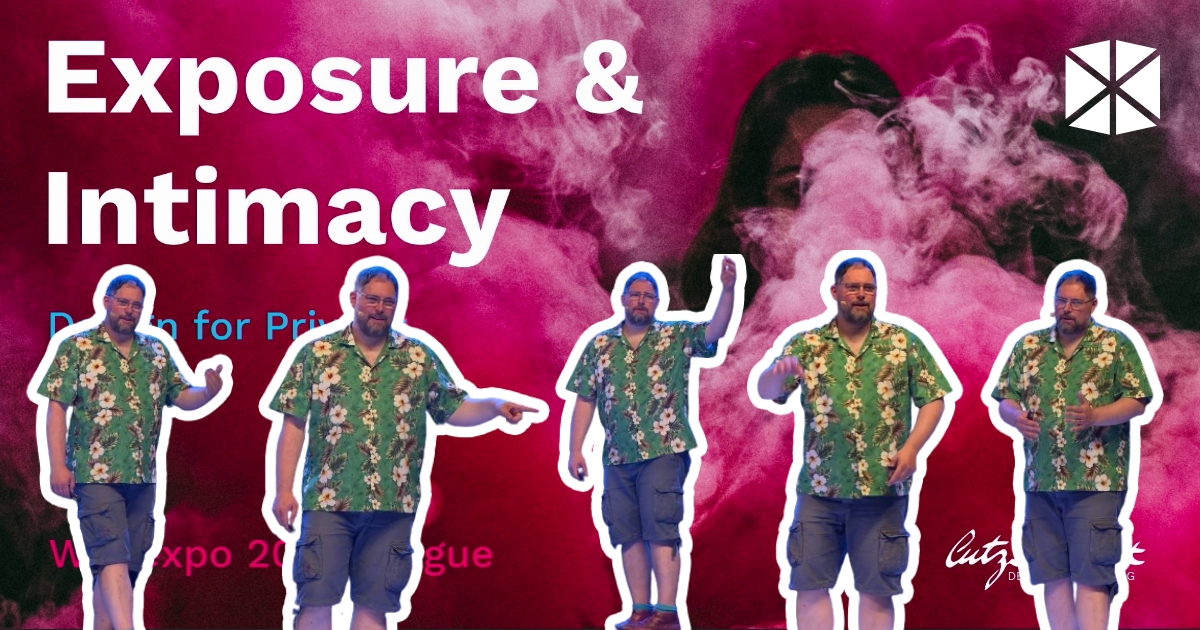
Public speaker, teacher and author, Lutz Schmitt uses wit and humour when discussing topics on privacy, design ethics and theory, and all things internet…as well as being an evil mastermind!
Have you ever thought about why some people take part in and release private videos of each other? Or how intimate that relationship must be in order for them to be comfortable in exposing such information?
Let’s take a closer look at intimate relationships within the context of the design aspect; explore ways to understand the privacy needs of users; and how to manage the challenging aspect of humane technology.
What is privacy?
We are social beings. We like to share. To communicate. To exchange ideas and thoughts. And to be together. However, we are picky. We are happy to tell others that we are popping to the bathroom, but we do not want them to watch!
“Privacy is the quality or state of being apart from company or observation [and] the freedom from unauthorized intrusion” – Definition of privacy taken from Marriam Webster Dictionary
The Greek philosopher Aristotle spoke about the Civic State Society. How under rules and norms, we all live together in a happy society. But he also spoke about the need to seclude ourselves. How individuals need to be alone in order to decide what they want to share, and what they do not want to share.
Thousands of years later, an essay on the right to privacy was published in the Harvard Law Review, in 1890. This set the foundations for all the regulations on privacy we now have today.
It comes down to one single line we “all have the right to be let alone”.
Limitations to the right of privacy
Unfortunately, being left alone is not universal.
If someone is deemed as a person of interest, the right to privacy ceases. Society’s general interest in that person allows for information to be published.
Privacy also ceases when the individual gives their consent. Or upon the publication of facts by the individual himself; it would be silly to publish something and then say I don’t want you to look at it.
It’s now easy for everyone to publish something. The internet. It’s accessible to everyone, well mostly everyone. And it does not forget.
Once it’s on the internet…it’s there FOREVER! (Cue echo sounds)
People started to exploit this lack of privacy. The result? Cookies. Cookie banners can obtain consent from individuals to obtain their personal information.
How easy is it to simply click on ‘Accept’? Have you ever clicked on ‘More Details’?
What do you think your users click on?
Choosing the simple option in clicking ‘Accept’ allows personal information to be shared with various marketing companies. In fact, there can be over 500 marketing companies ready to take that information. Success for them right?
Privacy and Freedom
The right to privacy is crucial and essential to one’s freedom. If the state/organisations are ripping information out of us…we do not have freedom.
Lutz introduces us to 4 different states of privacy:
- Solitude
- Reserved
- Intimacy
- Anonymity
Which state are we in when surfing the net?
Solitude? You’re by yourself.
Anonymity? No one knows you’re on the net.
No. It’s intimacy.
We can be intimate with a partner, friends, family, work colleagues, and even businesses and apps. You don’t need to be close to someone to be intimate with them. We entrust the other party that they won’t break that relationship and keep any information we provide them, private.
Helen Nissenbaum wrote a book titled ‘Privacy in Context’ (2010) – buy this book… it’s a good one! She explains, as the title suggests, privacy in different contexts. She describes which information belongs to which social context etc. and provides a framework for individuals’ expectations of how their personal information flows through society.
Different contexts have different rules.
Take people standing at a bus stop as an example. They are probably standing a few meters apart to give themselves some privacy. Then they all go to a sauna. All of a sudden, the social context has changed resulting in them being extremely close to one another. Organisations need to identify the social context of their users. Are they on the bus top or in the sauna?!
Acting in accordance with the user’s privacy
It’s great when you’re driving along and Google announces there is a traffic jam ahead and reroutes. Live updates using users’ smart devices that are not moving to show a traffic jam…great idea!
Not so great if you are fleeing a war zone.
Although private information has not been shared and is not individually recognizable, knowing where citizens were when escaping made them a sitting target.
It took Google 1 day to switch off this service in Ukraine.
Google, Apple and other marketing companies are the Gatekeepers. They keep you private. It’s a selling point.
However, they will still own the device. Not you. This may not be avoidable, but is a point worth mentioning.
We need to save the intimate relationship between users and apps/companies/businesses etc.
It can start with being honest.
Would you click ‘Accept’ or ‘I want to share my personal data with 542 ad tech companies’?
There is a delicate balance between the wish for exposure and the need for intimacy and privacy. Living in a modern libertarian society allows this right for everyone.
However, the internet offers a new way of exposure.
We need to focus on the users’ needs.
For more information on intimate relationships and exposure, Lutz is here to give you the full rundown in the awesome presentation recorded live at WebExpo.

